![]()
Wed, Sept 15, 2010 | The Meir Amit Intelligence and Terrorism Information Center
Turkish Journalist: Mavi Marmara Crisis Was a Calculated Gamble
Preparations made by IHH for confrontation with the IDF and the violence exercised by that organization’s operatives as photographed and documented in a book by Şefik Dinç, a Turkish journalist who took part in the Mavi Marmara flotilla.
Overview
Several books about the flotilla incident have been recently published in Turkey. One of them was written by Şefik Dinç, a reporter for the popular Turkish newspaper Habertürk, who was on board the Mavi Marmara during the last flotilla. Şefik Dinç captured images of the violent confrontation between IHH operatives and their supporters on one hand and IDF soldiers on the other, concealed his photographs from the Israeli security forces, and managed to smuggle them into Turkey.
Şefik Dinç’s account is fairly balanced, giving considerable weight to events that he personally witnessed and experienced. While the IHH narrative is given at length, the author does not hesitate to expose the extreme violence used by IHH operatives against the IDF and criticize the Turkish government for not stopping the flotilla. “Let’s face it: the Mavi Marmara crisis was a calculated gamble,” writes Dinç in the foreword to his book. “People on the street said that Israel would not let the siege be broken. The Turkish government, by not preventing the incident, and the IHH, by insisting on entering Gaza, led to a harsh, non-compromising reaction from Israel, destabilizing the Middle East region again”.
The photographs and verbal descriptions match the plenty of information, according to which IHH operatives had made a well-designed plan to conduct a violent confrontation with the IDF. The author photographed IHH operatives beating IDF soldiers with iron bars and clubs (taken from a secret stash), kidnapping three of them, beating injured IDF soldiers after they were kidnapped, and trying to throw one of them into the sea. The journalist, who had earlier heard IHH leader Bulent Yildirim say in an interview that the resistance would be passive, witnessed and documented so-called “passive resistance” turning practically into violent behavior.
The author’s description clearly shows that IDF soldiers did not open fire until after other soldiers were attacked and taken hostage. He also quoted Bulent Yildirim’s deputy Hüseyin Oruç as saying that there had been no attempts from the Turkish government to recall the ships or prevent the flotilla from sailing.
Following is a selection of photographs and descriptions from the book concerning the preparations made by IHH operatives and their supporters for the confrontation, giving the reader a good idea of the extreme violence they used against IDF soldiers. In some cases, we chose to verify those descriptions against the information we have on the confrontation.
Preparations for the confrontation
In his book, Şefik Dinç mentions that the volunteers on board the Mavi Marmara held lively discussions about the possibility of Israel attacking the ship. The operatives were ready for any scenario and even expressed their readiness to die, as long as the “siege” was broken (pp. 23-24). That description matches the information we have collected, according to which seven out of the nine people killed had declared themselves one way or another willing to die as shaheeds prior to the violent confrontation (see our July 12, 2010 Information Bulletin: “According to well-documented information, seven of the nine Turks killed in the violent confrontation aboard the Mavi Marmara had previously declared their desire to become shaheeds (martyrs). Eight of them belonged to Islamist Turkish organizations and not one of them was a peace activist or human rights worker”).
While waiting for the confrontation, some operatives began training for a potential Israeli attack. They practiced using fire hoses to thwart possible attempts by IDF soldiers to board the ship; they were instructed on the use of gas masks and told how to resist Israeli soldiers. They were also told that, as soon as the ship entered Israel’s territorial waters, additional guards would be deployed and passengers would be given a warning signal. Each person in charge of passenger security was given a specific location to report to when the alarm sounded (pp. 36-37).
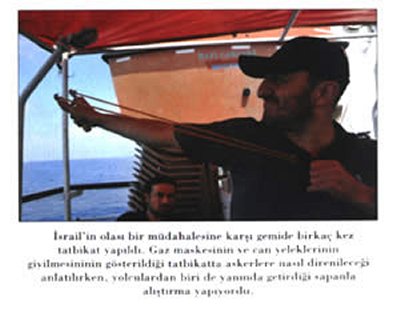
The text reads: Several exercises were held on board the ship to prepare in advance for a possible attack. In one exercise, the passengers were instructed on how to put on gas masks and lifebelts, and how to resist the Israeli attack. The photograph shows one of the passengers practicing with a slingshot he had brought along. (Note: 1)

The text reads: By the time the soldiers started boarding the ship, the passengers had already completed their preparations. They had put on lifebelts and gas masks and began resisting the Israeli soldiers using the iron bars and wooden clubs they held in their hands.
Once contact was made between the Mavi Marmara and Israeli navy boats, the ship’s passengers were woken up by IHH operatives and their supporters, who gave the passengers lifebelts and gas masks and prepared them for a confrontation with the IDF soldiers. When everyone who had been assigned a task reported to their (pre-determined) stations, clubs were taken out of a hiding place. “In addition to the wooden clubs I’d seen earlier, there were now iron bars as well”. “They were made from the railing around the ship” (p. 43).[2] Şefik Dinç’s description matches a great deal of reliable information we have in our possession, and strongly contradicts Bulent Yildirim’s remark (made at a press conference called during the flotilla’s voyage) that “we don’t even have one pocket knife” (p. 39).[3]
“According to what I saw,” says Şefik Dinç, “resistance to a possible boarding attempt by Israeli soldiers is not going to be that passive” (p. 43).[4] From time to time, the leader of IHH was seen giving terse instructions. As it turned out, “there was some discrepancy between the passive resistance [mentioned by Yildirim] and the preparations for [active] resistance that were taking place at the time.”[5] It was in that setting, writes Dinç, that journalists took their cameras and started documenting those moments and sending them back to their newspapers (p. 43).
Speaking to TV reporters on board the Mavi Marmara several hours before the IDF assault, IHH leader Bulent Yildirim stated that “soon we will see the true face of Israel”. He further added, “we will defend ourselves here. We are aware of the price we’ll have to pay. But we did take into consideration that we may have to sacrifice ourselves for the sake of humanity. We shall not retreat, and everybody will see the Israelis pull back” (p. 44).
Description of the fighting
At approximately 04:02, when Şefik Dinç was on the upper deck, the IDF’s Zodiac boats came into view and surrounded the Mavi Marmara. Satellite communications were cut off, forcing reporters to switch to alternative satellite frequencies. Gas, stun, and smoke grenades were fired from the boats. Women and older people started making their way to the interior of the ship. “At that point, the people chosen to take part in the resistance effort put on their gas masks.” The Israeli offensive, utilizing the Zodiac boats, was met by defensive action from the operatives. Another group began spraying the Zodiac boats with water from a fire hose and blinding the soldiers with spotlights. Some operatives started throwing glass bottles, which missed their mark because the Mavi Marmara and the boats were on the move (pp. 45-46).

The text reads: IHH leader Bulent Yildirim as the helicopters started their descent. He was photographed smiling to the camera and holding a communications device.
Shortly after the Zodiac boats appeared, a Sikorsky helicopter began approaching the Mavi Marmara and descending over the captain’s command bridge. Once it was close, commandos started sliding down on ropes from the helicopter. Three soldiers who dropped near the command bridge were taken hostage by a group of operatives as soon as they came on board. The three hostage soldiers were taken to the lower deck.[6] At that stage, shots were heard. Judging by the sound, Dinç assumed that plastic bullets were being used. However, he said that it wasn’t long before the soldiers began using live ammunition (pp. 46-47).[7]
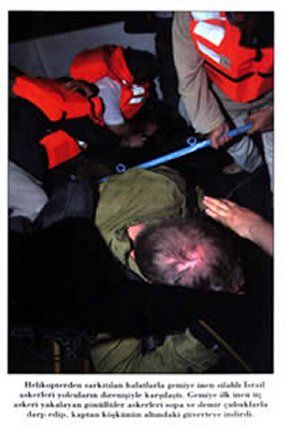
The text reads: The soldiers who rappelled from the helicopters were met with resistance from the passengers. The first three soldiers were caught, beaten with iron bars and wooden clubs, and taken to the space below the captain’s command bridge.
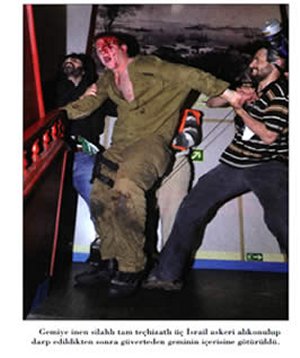
The text reads: After the three well-armed soldiers landed on the ship, they were beaten and taken to the ship’s interior.
The operatives waiting on the upper deck put the captive soldiers on the floor. Those soldiers were beaten with iron bars and clubs; they were kicked and slapped. Some operatives attempted to throw the soldiers taken to the lower deck into the sea. A soldier hanging in the air during an attempt to throw him into the sea was rescued thanks to the intervention of other people, who prevented that from happening. The soldiers who had sustained injuries to their faces and heads were taken down to the hall on the second floor. The soldiers had blood on their faces and were very scared. One of them, held by two people who had taken him inside, kept screaming for a doctor (p. 47).

The text reads: The soldier who was beaten with iron bars and wooden clubs. His face was stained with blood, and fear showed in his eyes as he was taken to the interior of the ship.

The text reads: The captive soldiers were surprised when they were taken inside the ship, just as they had been surprised to be caught when they came on board. Perhaps deep inside, they thought they were going to be executed. It is thanks to the intervention of several volunteers that the IDF soldiers did not take a heavier beating.

The text reads: As doctors attempted to treat the kidnapped soldiers in the corridors, they also attempted to keep the passengers from further beating.

The text reads: The weapons of the soldiers who were taken to the lower deck were thrown into the sea. (see note: 8) There was also an attempt to throw one of the soldiers into the sea.
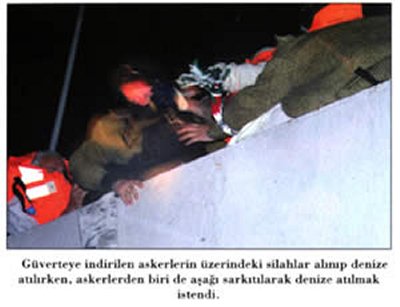
The text reads: Several volunteers intervened and prevented other angry volunteers from throwing the soldier into the sea.
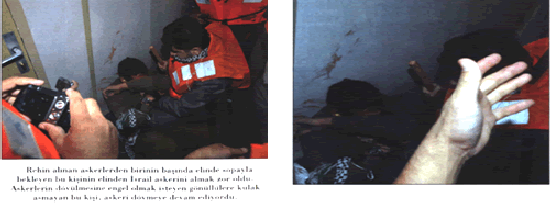
The text reads: It was difficult to get the kidnapped soldiers out of the hands of the man with the club. He ignored the requests of the volunteers who wanted to protect the soldier, and kept beating him.
As the soldiers were taken hostage, shots were heard from the helicopter.[9] According to Şefik Dinç, the commandos, who had until that point used plastic bullets, switched to live ammunition. Most of the people killed were on the upper deck; however, some were killed or injured on the lower decks as well. Doctors and several operatives who saw the dead claimed that two people had been shot dead in the head (p. 48).
When Şefik Dinç saw the three IDF soldiers being caught and beaten by the operatives, he realized that the situation had gotten out of control and assumed that many people would be killed. In a short period of about 20 minutes, nine people were killed and over 30 were injured. He added that the number of casualties could have been greater if it wasn’t for the IHH leaders’ call to cease the resistance (p. 48).
Did the Turkish authorities attempt to talk the IHH operatives out of launching the flotilla?
Turkey demanded that Israel apologize for its actions, Israel rejected that demand and accused Turkey of supporting the flotilla. During a visit to the US, the Turkish PM’s Chief Advisor Ibrahim Kalin said that the authorities had advised the IHH operatives against sailing: “We tried to convince them, we explained to them the difficulties and the risks, and that they should weigh once again whether or not to set sail (p. 78).
Turkish opposition leaders criticized the government by asking why no members of the ruling AKP party had been on board the Mavi Marmara. According to Dinç, MIT (the Turkish National Intelligence Organization) issued a warning to the government, and it is based on that warning that parliament members chose not to take part in the flotilla (p. 78).
Aslı Aydıntaş, a reporter for the opposition newspaper Milliyet, published an interview with Hüseyin Oruç, Bulent Yildirim’s deputy. Yildirim’s deputy was asked to comment on the claim that, when the flotilla had come near the Israeli coast, IHH consulted with MIT and AKP, which advised IHH not to proceed. Hüseyin Oruç responded by saying that “we received no recommendation from MIT or AKP. It was a long operation… We had been announcing the flotilla on the media for two months. Other than that, there was no discussion. We can clearly state that there were no attempts to bring us back, and there was no such suggestion from MIT. The decision was made by IHH, and we did not hide it from anyone…” (pp. 73-74).
Notes:
[1] Numerous slingshots of different kinds had been brought on the ship. Also found were marbles, stones, and nuts and bolts prepared in advance for the confrontation.
[2] The description of advance preparations for a violent confrontation with Israel matches the information in our possession. The preparations for fighting included the assignment of posts, preparation of weapons, setting up communications between the operatives, and establishing medical services for the operatives.
[3] One hundred iron bars of different lengths were found on board the Mavi Marmara. They were made from the ship’s iron railing. Also found were 50 improvised clubs, as well as standard-issue clubs brought on the ship and hidden inside rolled-up blankets. Yildirim’s remark that the operatives do not even have “one pocket knife” is a blatant lie.
[4] Şefik Dinç writes that, speaking at a press conference called on board the ship prior to that, Bulent Yildirim had said that “we will resist passively”.
[5] Yildirim’s public statements, aimed at Western target audiences and human rights organizations that joined forces with IHH, are characterized by toned-down terminology, with such phrases as “humanitarian purposes” and “passive resistance”. Şefik Dinç is correct in pointing out that there is a considerable discrepancy between those statements and IHH’s actual behavior, as it was witnessed by Dinç.
[6] Taking soldiers hostage in violent confrontations is not a new tactic of IHH. In January 2010, IHH operatives engaged in a violent confrontation with Egyptian security forces who refused to let them enter the Gaza Strip, during which hostages were taken by IHH operatives. Bulent Yildirim described the incident as follows: “…They [Egyptian security forces] detained seven of our members. We reacted to their attack. We took seven Egyptian soldiers captive. We released three soldiers who were injured. We kept four soldiers. We were willing to release them in exchange for the release of our people. After the first attack, the Egyptian soldiers surrounded us on sea and on land. We were under siege, [in a situation] where they could attack us again” (on5yirmi5.com, January 5, 2010; http://ihh.org.tr/12630, January 6, 2010).
[7] According to our information, IHH operatives and their supporters fired live ammunition as soon as the first soldiers descended from the helicopter. One IDF soldier suffered a knee injury from a non-IDF weapon as soon as he came on board the ship. IDF forces were forced to return fire using live ammunition since they were attacked and their lives were clearly at risk.
[8] According to our information, IHH operatives used three weapons taken from the Israelis against other IDF soldiers. It appears that two of them were thrown into the sea, as were one or two non-IDF weapons, at least one of which was used to fire on the commandos descending from the helicopter.
[9] The IHH’s version that shots were fired from the helicopters at the Turkish operatives is not true. IDF soldiers on board the Mavi Marmara were forced to shoot specifically at the operatives who attacked them, when their lives were at risk. No shots were fired from the helicopter.



 RSS
RSS

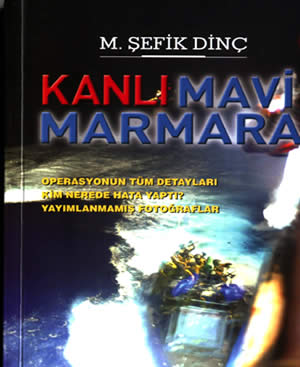


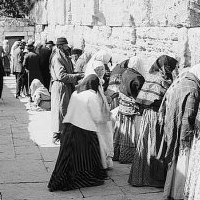
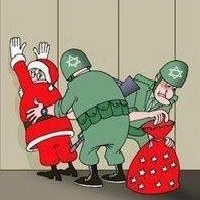





Turkish Journalist: Mavi Marmara Crisis Was a Calculated Gamble #turkey #gaza #IHH #israel http://j.mp/9yKIY2
RT @CrethiPlethi: Turkish Journalist: Mavi Marmara Crisis Was a Calculated Gamble #turkey #gaza #IHH #israel http://j.mp/9yKIY2
[…] no attempts from the Turkish government to recall the ships or prevent the flotilla from sailing. Read the full article here. Public date: September 27th, 2010Categories: NewsTags: "Freedom Flotilla", ?efik Dinç, Hamas, […]
[…] a TV interview, Turkish journalist Şefik Dinç, who was on the Mavi Marmara and wrote a book about it, said that no shots were fired from the Israeli helicopters and that IDF soldiers did not […]